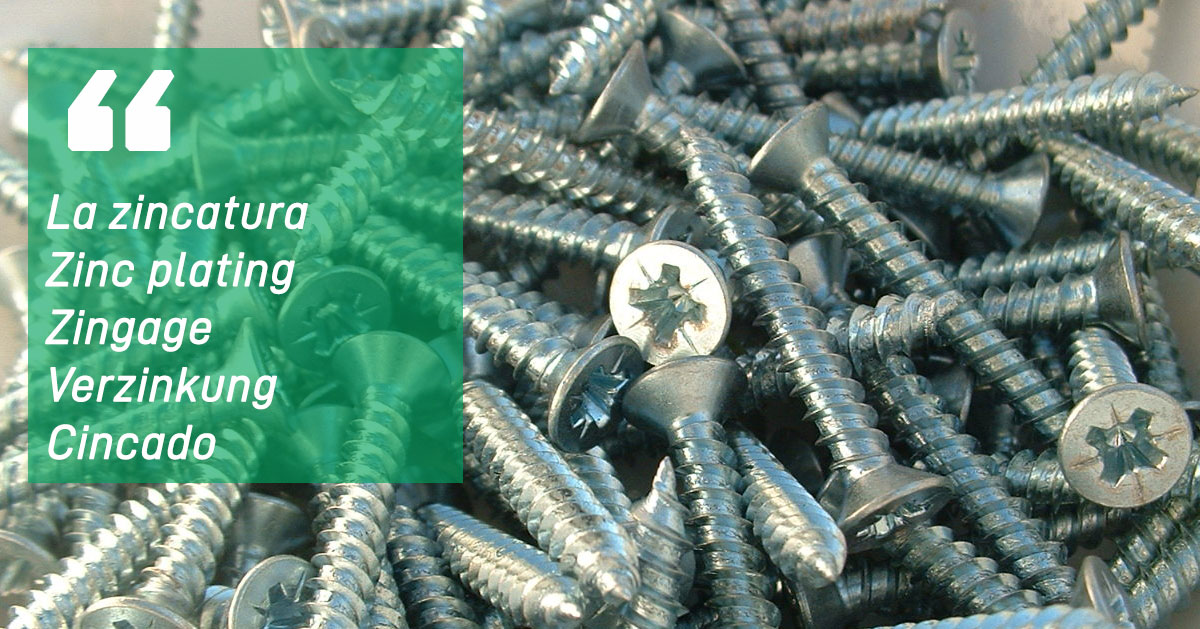
What is zinc plating?
Steel is the most common material in use today. However, it has a high corrosion rate and needs to be adequately protected by the electrochemical reaction of water, oxygen and other corrosive materials.
Zinc’s excellent corrosion resistance in several environments makes it suitable, to provide an effective protective coating on a variety of iron and steel products and in many exposure conditions.
For these reasons, zinc plating is the most common of the electrolytic coatings and is frequently applied under painting to improve the anti-corrosion performances and paint adherence as well.
The process is obtained by immersion of metal parts to coat in bath with suitable reagents, and Zinc ions presence. Once applied a voltage the piece to coat is used as anode (+) pulling Zinc ions (-) in solution that heap themselves around it returning neutral.
As a result, a thin zinc layer, at room temperature, is deposited onto the metal surface by means of electrolysis.
The Zinc layer thickness which is obtained with this process is not homogeneous, because zinc tends to cumulate around screw’s ends and on thread crests due to electrolytic process.
Moreover, thickness varies on account of the size of pieces, time permanence in bath and intensity of voltage.
A complete offer of solutions that fit all customer exigencies
VIPA offers a wide range of electrolytic zinc plating with different appearance and thickness.
The standard thickness of the coatings is 5 µm but it can differ accordingly client’s specifications (3-12 μm).
However, the protective layer thickness is necessarily very thin to not influence the piece tolerance.
Even though corrosion protection is directly proportional to the electroplate thickness, electrolytic galvanization provides a solid covering against corrosion under two aspects.
First of all, it creates a barrier effect, preventing oxygen and moisture from reaching the steel surface.
Secondly, zinc plating provides a cathodic protection against oxidation when the ferrous base of
the items gets exposed to corrosive agents. In practice zinc layer acts as sacrificial anode corroding instead of the protected metal. That is to say, the chemical reactions of corrosion affect the zinc in preference to the steel.
Due to low thickness of layers and scratches, electrogalvanizing is, however, susceptible to lose efficacy in the course of time. This is the result of zinc oxidation that consists in the formation of a white
powder on the surface of metal parts.
To improve the resistance of the zinc exterior layer a further treatment or topcoat is normally applied.
For example, chromatizing process that consists in the creation of a further electropositive layer of chrome oxide, guarantees a higher protection against corrosion and delays the formation of Zinc oxide.
Dehydrogenation
Zinc plating is a valid treatment, that is suitable, in particular, for low tensile fasteners. It guarantees a moderate galvanic corrosion protection and a pleasant appearance with a lower cost than other treatments.
However, this technique is susceptible to provoke the hydrogen embrittlement process that tends to undermine the material.
In practice, when a carbon steel alloy is submerged in an electrolytic bath (zincing) the hydrogen ions in the solution react with the carbon atoms.
As a result, the mechanical features of the material could be compromised until the breakage.
This problem is partly solved by the dehydrogenation treatment that facilitates the removal of hydrogen from the molecules of the compound.
Nevertheless, the hydrogen embrittlement phenomenon is so dangerous and unpredictable and the effect of the dehydrogenation so uncertain that the electrolytic zinc plating is to avoid for high tensile fasteners (class 10.9) and to exclude for higher resistance classes.